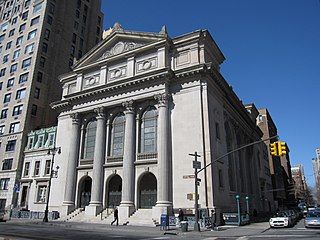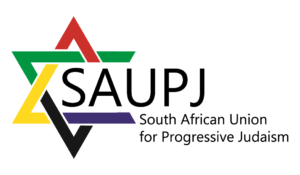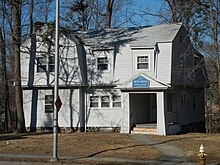
Conservative Judaism is a Jewish religious movement that regards the authority of Jewish law and tradition as emanating primarily from the assent of the people through the generations, more than from divine revelation. It therefore views Jewish law, or Halakha, as both binding and subject to historical development. The conservative rabbinate employs modern historical-critical research, rather than only traditional methods and sources, and lends great weight to its constituency, when determining its stance on matters of practice. The movement considers its approach as the authentic and most appropriate continuation of Halakhic discourse, maintaining both fealty to received forms and flexibility in their interpretation. It also eschews strict theological definitions, lacking a consensus in matters of faith and allowing great pluralism.

Mordecai Menahem Kaplan was a Lithuanian-born American rabbi, writer, Jewish educator, professor, theologian, philosopher, activist, and religious leader who founded the Reconstructionist branch of Judaism along with his son-in-law Ira Eisenstein. He has been described as a "towering figure" in the recent history of Judaism for his influential work in adapting it to modern society, contending that Judaism should be a unifying and creative force by stressing the cultural and historical character of the religion as well as theological doctrine.

Reconstructionist Judaism is a Jewish movement based on the concepts developed by Rabbi Mordecai Kaplan (1881–1983) that views Judaism as a progressively evolving civilization rather than just a religion. The movement originated as a semi-organized stream within Conservative Judaism, developed between the late 1920s and the 1940s before seceding in 1955, and established a rabbinical college in 1967. Reconstructionist Judaism is recognized by many scholars as one of the four major streams of Judaism in America alongside Orthodox, Conservative, and Reform.

The Orthodox Union is one of the largest Orthodox Jewish organizations in the United States. Founded in 1898, the OU supports a network of synagogues, youth programs, Jewish and Religious Zionist advocacy programs, programs for the disabled, localized religious study programs, and international units with locations in Israel and formerly in Ukraine. The OU maintains a kosher certification service, whose circled-U hechsher symbol, U+24CAⓊ, is found on the labels of many kosher commercial and consumer food products.
The Union of Orthodox Rabbis of the United States and Canada (UOR), often called by its Hebrew name, Agudath Harabonim or (in Ashkenazi Hebrew) Agudas Harabonim ("union of rabbis"), was established in 1901 in the United States and is the oldest organization of Orthodox rabbis in the United States. It had been for many years the principal group for such rabbis, though in recent years it has lost much of its former membership and influence.
Conservadox is the term occasionally applied to describe either individuals or congregations located on the religious continuum somewhere between the Conservative and Modern Orthodox wings of American Jewry. The epithet "Traditional" is also sparingly used for roughly the same sector, as in the Union for Traditional Judaism.

The World Union for Progressive Judaism (WUPJ) is the international umbrella organization for the various branches of Reform, Liberal and Progressive Judaism, as well as the separate Reconstructionist Judaism. The WUPJ is based in 40 countries with 1,275 affiliated synagogues, of which 1,170 are Reform, Progressive, or Liberal and 105 Reconstructionist. It claims to represent a total of some 1.8 million people, both registered constituents and non-member identifiers. The WUPJ states that it aims to create common ground between its constituents and to promote Progressive Judaism in places where individuals and groups are seeking authentic, yet modern ways of expressing themselves as Jews. It seeks to preserve Jewish integrity wherever Jews live, to encourage integration without assimilation, to deal with modernity while preserving the Jewish experience, and to strive for equal rights and social justice.

The Congregation Shearith Israel – often called The Spanish and Portuguese Synagogue – is the oldest Jewish congregation in the United States. It was established in 1654 in New Amsterdam by Jews who arrived from Dutch Brazil. Until 1825, when Jewish immigrants from Germany established a congregation, it was the only Jewish congregation in New York City.
Open Orthodox Judaism is a Jewish religious movement with increased emphasis on intellectual openness and a more expansive role for women. The term was coined in 1997 by Avi Weiss, who views halakha as permitting more flexibility than the normal practices of Orthodox Judaism.

Adas Israel Congregation was a Modern Orthodox Jewish synagogue located in Duluth, Minnesota, established in the late 19th century. Until its destruction by arson on September 9, 2019, it was the oldest surviving Orthodox synagogue in Duluth having outlived and incorporated several Orthodox synagogues in the Twin Ports area. By 1973, it was the only Orthodox synagogue in Duluth.
Orthodox Jewish outreach, often referred to as Kiruv or Qiruv, is the collective work or movement of Orthodox Judaism that reaches out to non-observant Jews to encourage belief in God and life according to Jewish law. The process of a Jew becoming more observant of Orthodox Judaism is called teshuva making the "returnee" a baal teshuva. Orthodox Jewish outreach has worked to enhance the rise of the baal teshuva movement.

The baal teshuva movement is a description of the return of secular Jews to religious Judaism. The term baal teshuva is from the Talmud, literally meaning "master of repentance". The term is used to refer to a worldwide phenomenon among the Jewish people.

The Pacific Jewish Center, abbreviated as PJC and also known as the Shul on the Beach, is an Orthodox Jewish synagogue located at 505 Ocean Front Walk, in Venice, Los Angeles, California, in the United States. The synagogue is known for its outreach to unaffiliated and disconnected Jews. The Shul remains the last of the synagogues built in Venice during the first part of the 20th century. Although an Orthodox synagogue, worshippers who identify themselves as many different denominations are all welcomed when attending services and other events due to its location in an eclectic neighborhood.
Orthodox Jewish feminism is a movement in Orthodox Judaism which seeks to further the cause of a more egalitarian approach to Jewish practice within the bounds of Jewish Law. The major organizations of this movement is the Jewish Orthodox Feminist Alliance (JOFA) in North America, and Women of the Wall (WOW) and its affiliates in Israel and internationally, known as The International Committee for Women of the Wall (ICWOW). In Israel, the leading Orthodox feminist organization is Kolech, founded by Dr. Chana Kehat. In Australia, there is one Orthodox partnership minyan, Shira Hadasha, in Melbourne.

The Jewish Center is a Modern Orthodox synagogue on New York City's Upper West Side.

Masorti Olami is the international umbrella organization for Masorti Judaism, founded in 1957 with the goal of making Masorti Judaism a force in the Jewish world. Masorti Olami is affiliated with communities in over 36 countries, representing with partners in Israel and North America close to two million people worldwide, both registered members and non-member identifiers. Masorti Olami builds, renews, and strengthens Jewish life throughout the world, with efforts that focus on existing and developing communities in Europe, Latin America, the former Soviet Union, Africa, Asia, and Australia. More than 140 kehillot (communities) are affiliated with Masorti Olami in Argentina, Aruba, Australia, Bolivia, Brazil, Chile, Colombia, Cuba, the Czech Republic, Ecuador, El Salvador, France, Germany, Honduras, Hungary, India, Israel, Italy, Japan, Kenya, Mexico, the Netherlands, Paraguay, Peru, Poland, Portugal, Russia, South Africa, Spain, Sweden, Uganda, Ukraine, Uruguay, the United Kingdom and additionally, more than 600 in Canada and the United States and over 80 communities in Israel. All of Masorti Olami's activities are conducted within the context of the overall Conservative Judaism movement, in close cooperation with its affiliated organizations in North America and Israel. The current executive director is Rabbi Mauricio Balter.

The Jewish community of Houston, Texas has grown and thrived since the 1800s. As of 2008 Jews lived in many Houston neighborhoods and Meyerland is the center of the Jewish community in the area.

The South African Union for Progressive Judaism (SAUPJ) is an affiliate of the World Union for Progressive Judaism and supports 11 progressive congregations. Rabbi Moses Cyrus Weiler, a founder of Reform Judaism in the country, led the country's first Reform synagogue, Temple Israel in Hillbrow, Johannesburg. Weiler is credited with growing the movement, to represent 15-17% of South African Jewry and establishing 25 congregations in the country. A 2020 joint study by the Institute for Jewish Policy Research and the University of Cape Town showed that 12% of Jews identified as Progressive and that in relative terms the progressive strands are increasing after falling to 7% in 1998 and 2005 studies. In Johannesburg, the community accounts for 7% of the city's Jewry, rising to 18% in Cape Town and 25% in Durban.
Temple Israel, also known as the Cape Town Progressive Jewish Congregation (CTPJC), is a Progressive Jewish congregation in Cape Town, with three centres in Green Point, Wynberg and Milnerton. As three centres combined, they are the largest Progressive congregation in South Africa, and the second largest Jewish congregation in Cape Town after Marais Road Shul in Sea Point. The congregation first started in Green Point in 1944, eight years after South Africa's first progressive synagogue, also Temple Israel, opened in Hillbrow in Johannesburg. The Cape Town congregation caters to over 3000 Progressive Jews in the city. The congregation is an affiliate of the South African Union for Progressive Judaism, which is part of the World Union for Progressive Judaism (WUPJ). The congregation represents around 18% of Cape Town Jewry.
Black Jews in New York City comprise one of the largest communities of Black Jews in the United States. Black Jews have lived in New York City since colonial times, with organized Black-Jewish and Black Hebrew Israelite communities emerging during the early 20th century. Black Jewish and Black Hebrew Israelite communities have historically been centered in Harlem, Brooklyn, The Bronx, and Queens. The Commandment Keepers movement originated in Harlem, while the Black Orthodox Jewish community is centered in Brooklyn. New York City is home to four historically Black synagogues with roots in the Black Hebrew Israelite community. A small Beta Israel (Ethiopian-Jewish) community also exists in New York City, many of whom emigrated from Israel. Black Hebrew Israelites are not considered Jewish by the New York Board of Rabbis, an organization representing mainstream Rabbinic Judaism.














